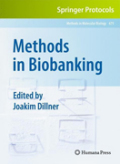
International biobank collaborations allow for studies with large number of subjects where generalizability of findings across populations can be investigated, which means establishing quality criteria concerning the nature of the sample, conditions of sample storage, and the adequacy of available information is of vital importance. Methods in Biobanking brings together contributions from experts in the field in order to aid in the establishment of this much needed consistency. The volume discusses how to use existing collections of biological material to answer significant questions concerning the cause of disease without violating the personal integrity of participating sample donors, the ethical issues surrounding biobanks, guidelines for the use of coding systems and the use of biocomputing and registry linkages in research projects, as wellas many other key subjects. As a volume in the highly successful Methods in Molecular Biology™ series, this collection provides the kind of detailed description and implementation advice that is crucial for getting optimal results. Authoritative and cutting-edge, Methods in Biobanking seeks to provide scientists with the tools necessary to take advantage of the tremendous current resources of the world’s biobanks and strengthen those resources for the future. Provides key insights into successful biobanking practices -Includes contibutionsfocused on perfecting and standardizing worldwide techniques as Written by current experts in the field -Features chapters on ethical considerations and specific clinical topics Using biobanks and registries INDICE: Genetic Research and Biobanks.- The Need to Down Regulate: A Minimal Ethical Framework for Biobank Research.- Nordic Biological Specimen Bank Cohorts as Basis for Studies of Cancer Causes and Control: Quality Control Toolsfor Study Cohorts with More than 2 Million Sample Donors and 100,000 Prospective Cancers.- Biobanks Collected for Routine Healthcare Purposes: Build-Up andUse for Epidemiological Research.- Biobanks and Registers in Epidemiological Research on Cancer.- Study Designs for Biobank-Based Epidemiologic Research onChronic Diseases.- The EPIC Biobank (European Prospective Investigation into Cancer and Nutrition).- The AIDS and Cancer Specimen Resource (ACSR).- Specific Advantages of Twin Registries and Biobanks.- The Swedish Multi-Generation Register.- Multigenerational Information: The Example of the Icelandic GenealogyDatabase.- Creation of a New Prospective Research Biobank: The Example of HUNT3.- Best Practices for Establishing a Biobank.- Extraction, Quantitation, andFunctionality Evaluation of DNA from Various Sample Types.- Cervical CytologyBiobanks as a Resource for Molecular Epidemiology.- Biobanking of Fresh Frozen Tissue from Clinical Surgical Specimens: Transport Logistics, Sample Selection, and Histological Characterization.- Protein Extraction from Solid Tissue.-Collection and Preservation of Frozen Microorganisms.- Handling of Solid Brain Tumor Tissue for Protein Analysis.- Blood Plasma Handling for Protein Analysis.- Biobank Informatics: Connecting Genotypes and Phenotypes.- A Practical Guide to Constructing and Using Tissue Microarrays.- Breast Cancer Genomics Based on Biobanks.- Monitoring, Alarm, and Data Visualization Service on Sample Preparing and Sample Storing Devices in Biobanks.- Fresh Frozen Tissue: RNA Extraction and Quality Control.
- ISBN: 978-1-58829-995-6
- Editorial: Humana
- Encuadernacion: Cartoné
- Páginas: 370
- Fecha Publicación: 29/10/2010
- Nº Volúmenes: 1
- Idioma: Inglés
